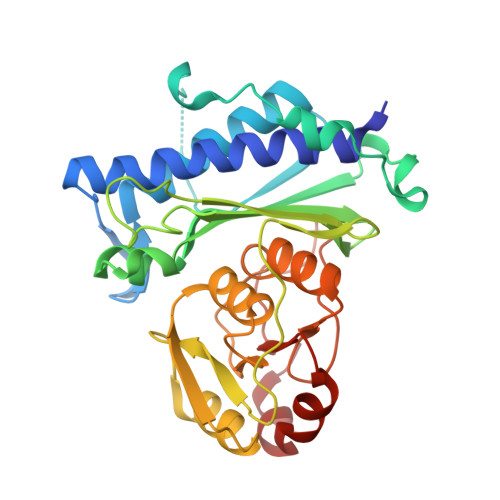Crystal structure of an enzyme displaying both inositol-polyphosphate-1-phosphatase and 3'-phosphoadenosine-5'-phosphate phosphatase activities: a novel target of lithium therapy.
Patel, S., Yenush, L., Rodriguez, P.L., Serrano, R., Blundell, T.L.(2002) J Mol Biology 315: 677-685
- PubMed: 11812139
- DOI: https://doi.org/10.1006/jmbi.2001.5271
- Primary Citation of Related Structures:
1JP4 - PubMed Abstract:
Lithium cations exert profound and selective psychopharmacological effects on ameliorate manic-depressive psychosis. Although lithium is an effective drug for both treatment and prophylaxis of bipolar disorder, the precise mechanism of action is not well understood. Lithium acts as both an uncompetitive and non-competitive inhibitor of several lithium- sensitive phosphatases with regard to substrate and magnesium cofactor, respectively. In this work, we report the crystal structure and reaction mechanism of Rattus norvegicus 3'-phosphoadenosine 5'-phosphate and inositol 1,4-bisphosphate phosphatase (RnPIP), a recently identified target of lithium therapy. This Li(+)-sensitive enzyme plays a crucial role in several cellular processes, such as RNA processing, sulphation reactions and probably inositol recycling. RnPIP specifically removes the 3'-phosphate group of 3'-phosphoadenosine 5'-phosphate (PAP) and the 1'-phosphate group of inositol 1,4-bisphosphate (I(1),(4)P(2)) producing AMP and inositol 4'-phosphate, respectively. The crystal structure of RnPIP complexed with AMP, Pi and magnesium ions at 1.69 A resolution provides insight into the reaction mechanism of the hydrolysis of PAP. The core fold of the enzyme is equivalent to that found in other Li(+)-sensitive phosphatases, such as inositol monophosphatase, but molecular modelling of I(1),(4)P(2) in the RnPIP active site reveals important structural determinants that accommodate this additional substrate. RnPIP is potently inhibited by lithium and, as the accumulation of PAP inhibits a variety of proteins, including sulphotransferases and RNA processing enzymes, this dual specificity enzyme represents a potential target of lithium action, in addition to inositol monophosphatases.
- Department of Biochemistry, University of Cambridge, 80 Tennis Court Road, Cambridge, CB2 1GA, UK.
Organizational Affiliation:




















